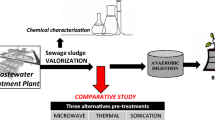Abstract
Modern municipal sewage waste treatment plants use conventional mechanical and biological processes to reclaim waste waters. This process has the overall effect of converting a water pollution problem into a solid waste disposal problem (sludges). The costs for conventional disposal of sewage sludges have risen dramatically because of increased environmental mandates, which restrict their disposal, as well as a dwindling number of landfills. Previously, we determined that secondary bioprocessing (specifically anaerobic digestion) was not effective in reducing the organic content and bulk of the sludge waste (1). Therefore, we have examined the potential of a variety of pretreatment technologies designed to disrupt the macrostructure of the sludge and thereby enhance its subsequent biodegradation. Two thermal/mechanical pretreatments tested were found to have a dramatic effect on the subsequent bioconversion of the microbial sludges. Both technologies evaluated, sonication and shear, were found to be affected by sludge solids levels, duration of treatment, and treatment temperature. Optimum sonication pretreatment occurred with sludge solids of 1% and treatment times of 4–8 min. The most effectivee treatment temperature tested was 55°C. The optimum enhancement in bioconversion potential for the sonication pretreatment was 80–83% of the materials carbon oxygen demand (COD) content. The optimum shear pretreatment occurred with sludge solids of 1–2% and treatment times of 6–10 min. The most effective treatment temperature tested was 87°C. The optimum enhancement in bioconversion potential for the shear pretreatment was 88–90% of the material’s COD content. These data were the basis for US patent no. 5,380,445, granted January 10, 1995.
Similar content being viewed by others
References
Rivard, C. J., Nagle, N. J., and Himmel, M. E. (1991), “Secondary Anaerobic Digestion of Treated, Highly Dewatered Municipal Sewage Sludges Using a Novel High Solids Reactor. ” American Chemical Society presentation, Atlanta, GA.
Metcalf & Eddy, Inc. (1979),Wastewater Engineering: Treatment, Disposal, Reuse. McGraw-Hill, New York.
US EPA (1979),Process Design Manual for Sludge Treatment and Disposal, Sept. EPA 625/1-79-011, Environmental Research Information, Cincinnati, OH.
Arora, M. L. (1976),Water and Sewage Works 123, 74–79.
Federal Register (1989), Standards for the Disposal of Sewage Sludge, Proposed Rule, Feb. 6, 1989.
Downing, A. L. (1933), inEcological Aspects of Used-Water Treatment, vol. 2, Curds, C. R. and Hawkes, H. A., eds., Academic, New York.
Ramalho, R. S. (1983),Introduction to Waste-Water Treatment Processes, 2nd ed. Academic, New York.
Federal Register (1972), Federal Water Pollut. Control Act of 1972 (PL 92-500).
Federal Register (1987), Federal Water Quality Act of 1987 (PL 100-4).
Reed, S. C., Middlebrooks, E. J., and Crites, R. W. (1988),Natural Systems for Waste Management and Treatment, McGraw-Hill, New York.
Samela, D., Tsoumpas, G. M., Welshans, G. K., and Zwillenberg, M. L. (1986),Environ. Progress 5, 110–115.
Laughton, P. J. (1979),Water and Pollut. Control 117, 14–17.
Mungsgaard, D. C. and Young, J. C. (1980),J. Water Pollut. Control Fed. 52, 2131–2141.
Rutherford, C. C. and Wolfe, G. R. (1986), “Realities of Sludge Dewatering,”Proceedings of the National Conference on Municipal Treatment Plant Sludge Management, Orlando, FL.
Novak, J. T., Prendeville, J. F., and Sherrand, J. H. (1988),J. Environ. Engineer. 114, 190–198.
Bandak, N. and Novak, J. T. (1986), “Polymer Performance in Sludge Conditioning,”Proceedings of the Eighteenth Mid-Atlantic Industrial Waste Conference, June, Lancaster, PA.
Doyle, C. L. and Haight, D. M., (1986), “Sludge Conditioning with Organic Polyelectrolytes,”Proceedings of the National Conference on Municipal Treatment Plant Sludge Management, May, Orlando, FL.
Knocke, W. R. and Zentkovich, T. L. (1986),J. Water Pollut. Control Fed. 58, 1118–1123.
Barraclough, G. O., Brown, D.J., Lordo, S. A., Santicola, H. J., (1986), “Start-up Optimization of the Mechanical and Chemical Parameters Influencing the Dewatering Performance of a Gravity Belt Filter Press Operation,”Proceedings of the Eighteenth Mid-Atlantic Industrial Waste Conference, June, Blacksburg, VA.
Badar, T. A. (1987),Tappi J. 70, 73–78.
Katsiris, N. and Kouzeli-Katsiri, A. (1987),Water Res. 21, 1319–1327.
Harries, G., Jones, C., and Milotte, G. (1987),S. Afr. Mech. Eng. 37, 481–485.
Cobb, W. and McIntyre, J. P. (1987), “Optimizing Belt Press Performance at Smurfit Newsprint,”Tappi Proceedings-1987 Environmental Conference, April, Portland, OR.
Nagle, N. J., Rivard, C. J., Adney, W. S., and M. E. Himmel (1992),Appl. Biochem. Biotech. 34/35, 737–751.
Greenberg, A. E., Conners, J. J., and Jenkins, D., eds. (1981), inStandard Methods for the Examination of Water and Waste Water, American Public Health Association, Washington, DC.
Rivard, C. J., Bortleaus, F. M., Hensen, J. M., and Smith, P. H. (1987),Appl. Biochem. Biotech. 17, 245–262.
Goering, H. K. and Van Soest, P. J. (1970), “Forest Fiber Analysis (Apparatus, Reagents, Procedures and Some Applications),”US Department of Agriculture Handbook #379.
Federal Register (1993), “Part 503-Standards for the Use or Disposal of Sewage Sludge,” Rules and Regulations.
Author information
Authors and Affiliations
Rights and permissions
About this article
Cite this article
Rivard, C.J., Nagle, N.J. Pretreatment technology for the beneficial biological reuse of municipal sewage sludges. Appl Biochem Biotechnol 57, 983–991 (1996). https://doi.org/10.1007/BF02941778
Issue Date:
DOI: https://doi.org/10.1007/BF02941778




